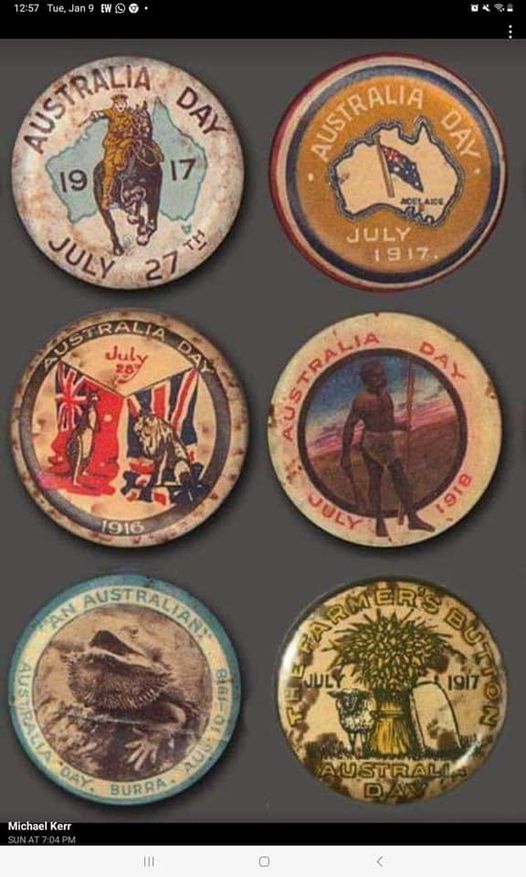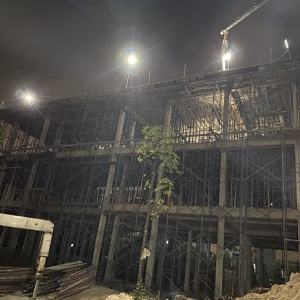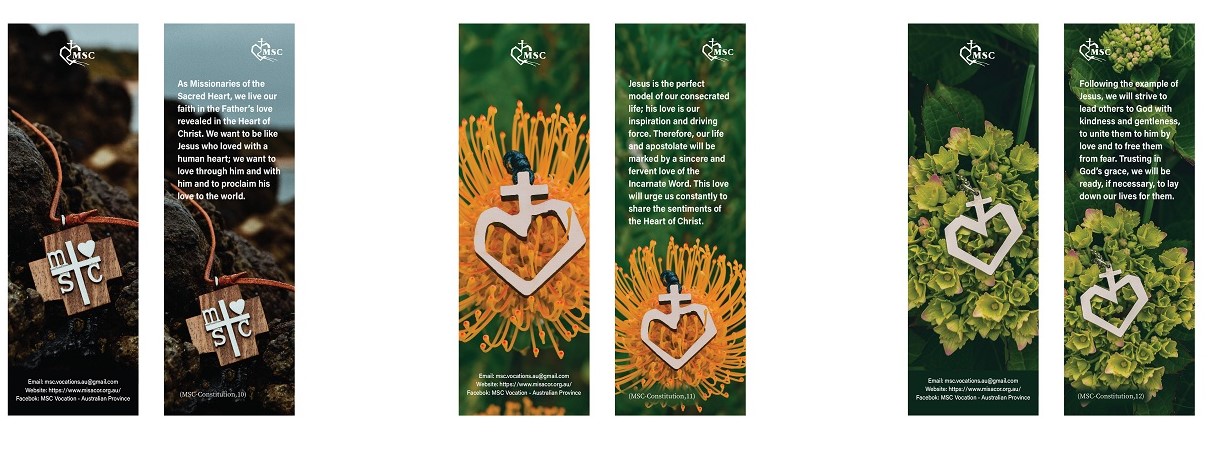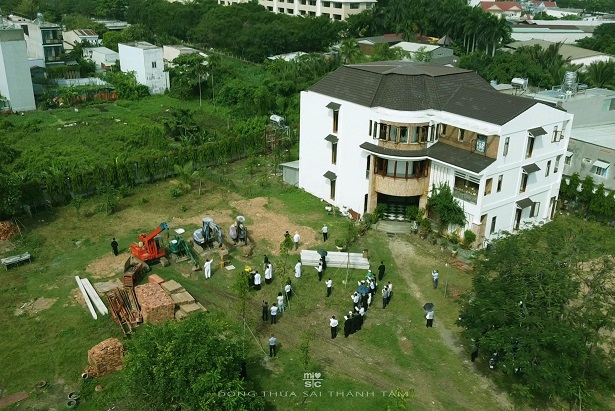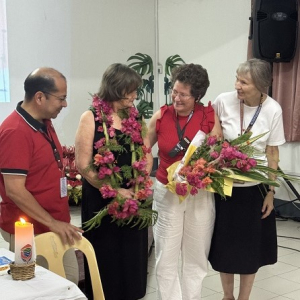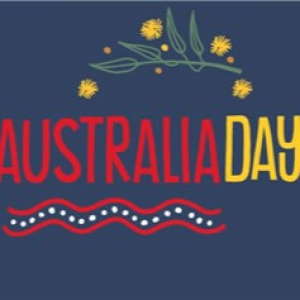Peter MALONE
Shame on Dry Land/ Syndabocken

SHAME ON DRY LAND/ SYNDABOCKEN
Sweden, 2023, 91 minutes, Colour.
Joel Spiro, Christopher Wagelin, Julia Sporre, Jacqueline Ramel, Tommy Nilsson.
Directed by Axel Petersen.
This is a Swedish drama, writing and directing, cast. However, it was filmed in Malta, the beauty of the past, the island and ocean, industrial development, the reliance on gambling in casinos.
The story is enigmatic, the audience introduced to a wandering sailor, Dimman, Joel Spiro whose first words uttered are of being sorry, wanting forgiveness. And this develops throughout the film, making the sale’s journey something of an experience of atonement and reconciliation.
He is coming to see his school friend with whom he worked, but their company was fraudulent, Dimman lying and abandoning his friend who has been unable to get employment, relies on his fiancee, and they are now preparing a marriage celebration.
Dimman is also dependent on a Swedish woman on the island who arranges tourists to take trips on his boat. She alerts him to a police investigator who is acting suspiciously and Dimman follows him, sees the contacts he makes, experiences one of the contacts committing suicide, discovers a container which the investigator has filled with money and possessions.
The audience realising the investigator is a fraud, then realises that he is targeting Dimman’s friend, which leads to violent confrontations.
There is a happy ending with the reconciliation of friends, financial security for the friend, happy wedding – and Dimman sailing away, his active atonement achievement.,
- The title, with reference to Dimman? The past? Frederick and his situation?
- A Swedish film, Swedish characters, the colony in Malta, connected with gaming, affluent and hedonistic life? Filming in Malta, the island and the sea, towns, the past, industrial present? Casinos?
- The offbeat musical score, often discordant and edgy?
- The mystery of the opening, Dimman and his arrival, by boat, in Malta, dress, attitudes, declaring that he was sorry, repeating it?
- The narrative as Dimman’s being sorry, some kind of atonement, rescuing Frederick, running risks, his future?
- Frederick and Sarah, attitudes towards Dimman on arrival, gradual revelation of the past, schoolfriends, working together, the company and fraud, Dimman lying and leaving, abandoning Frederick, Frederick and application for jobs and refusals, reputation, unable to raise a loan from banks? Hostility towards Dimman? Sarah, working in gaming, accomplished, love for Frederick, preparations for the wedding, her knowing about Dimman?
- Dimman, the wealthy woman, her gigolo, arranging the the sorting voyages, the clientele? Her boat? Suspicions about the police investigator? Dimman following him, observing him, at the casino with the woman, in his room and sexual behaviour, observing the container, the attack on Frederick, the money, the woman accomplice, the man on the boat and the suicide?
- The wedding, Pierre and his arranging the wedding, the scene at the casino, threatening? Frederick and his drinking, confronting Dimman? The other Swedes recognising Dimman and knowing his past?
- The wedding party, the celebration? Frederick and his desperation?
- Following the investigator, Dimman and his bike, in the car, finding Frederick in the house? The pursuit of the investigator, firing the bow, his falling over the cliff, Dimman trying to get to the body, to get the passport and documents? Frederick in swimming difficulties? The later return, finding the body, the investigator still alive and the fight, getting the documents back? Going to the container, Dimman taking money for expenses, the rest for Frederick, to buy an apartment?
- The confrontation with the woman, help from the gigolo, his Dimman the keys of the boat, her setting him up investigating the investigator? Targeting Frederick?
- Happy ending, the wedding and the happy couple, peer singing? And Dimman sailing out to his future, his reparation mission accomplished?
Rooster, The
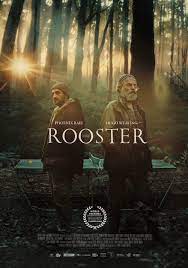
THE ROOSTER
Australia, 2023, 101 minutes, Colour.
Phoenix Raei, Hugo Weaving, John Waters, Rhys Mitchell.
Directed by Mark Leonard Winter.
There are some actual roosters in this film. But, there are some eerie roosters seen in nightmares. And, the rooster can stand as some kind of symbol for the two central characters, Dan (Phoenix Raei) and The Hermit (Hugo Weaving).
This is the feature film writing and directing debut from actor Mark Leonard Winter. In his performances, he is frequently dark and brooding. And he has brought these qualities to his film, dramatic, sometimes comic.
The setting is a small town in the Macedon Ranges outside Melbourne, rather isolated in the bush. And it has only one policeman, Dan, middle-aged, a sad past gradually revealed, driving around, a rather remote shed-office, sometimes a visit from the regional police chief, a brief welcome cameo from veteran, John Waters. He keeps chickens, and the rooster. And he has the dreams, repeated, a mysterious naked woman carrying a rooster, and a body hanging from a tree… Some premonitions of what is to come.
When a friend of Dan’s, with mental difficulties, and parents hostile to Dan, is killed, the man’s wandering dog leads Dan to the grave. But this also leads him further into the bush, coming across another remote house, and encountering Tim, also known as Mit, which is short from his nickname, The Hermit.
While Phoenix Raei gives a convincing performance as Dan, and our sympathies are with him, Hugo Weaving, giving time to Dan, takes over the screen, the dynamics of the story, another sad past gradually revealed, regrets. There are suggestions that something sinister but is this just speculation on Dan’s part, on the audience is part?
The Rooster shows us Hugo Weaving at his screen best, reminding us that he has top line films and television series for decades. He can make each character he portrays a real and convincing.
This is a film about men, sad men, men who become friends, but also wary of each other. The symbol of the growing friendship, apart from alcohol, is The Hermit’s continued invitation to Dan to play table tennis with him.
So, sometimes brooding, sometimes funny, so many sad stories, so many sad pasts, and the discovery of how much a friendship can change the friends, coming to terms with the past, some moments of happiness.
- The title? The actual roosters, Dan’s favourite, feeding it, challenging it, finding the foxes have killed it? The naked woman in his nightmares giving him the rooster? The final bonding with the new rooster? The symbolic theme of roosters?
- The Victorian countryside, the town and the stores, the bush, the Hermit in the bush, homes and interiors? Atmosphere? The musical score?
- The opening, Dan and his nightmare, the man hanging on the tree in the distance, the naked woman and the rooster, Dan in the car, trying to make contact, to be heard? The reprisal of the nightmare? Illuminating his psyche?
- The revelation that Dan was police, at home, by himself, feeding the chooks, with the rooster, the eggs? Driving to the police hut? The episode with Steve, the audience seeing Steve going through the bush, taking off his clothes, the children playing sport nearby, the gathering of his clothes, Dan putting the blanket over him, taking him home, the episode with his parents and their rejection of Dan? The dog, nickname Boss, at the door, in the middle of the road, leading Dan to Steve buried in the bush?
- The effect on Dan, travelling through the bush, discovering the Hermit, isolated, his hut, having the bath, calling Dan a pervert, pursuing him? Dan, his return, bringing the alcohol? The core of the film and his bonding with the Hermit? His wanting to find out the truth of what happened to Steve in his death?
- Hugo Weaving’s portrait of The Hermit, Mit, his real name Tim? Audience response to them, in his house, the bath, naked, his aggression towards Dan? The mysterious background, the photo of wife and daughter? Alcoholic? His anger at Dan, saying his father stole his pay packet (number later explanation that it was taken to give to support his wife and daughter)? The tentative steps, conversation, the importance of the table tennis games, their recurring, the baths, naked? Talking, bonding? Dan and his suspicions, the locked box, the remnant of the fluffy toy? The Hermit gradually talking about the death of Steve, the deal with his motor, burying him?
- The effect on Dan, the bonding with the Hermit, some friendship in his life, his explanation about his past relationship, unable to have children, his partner leaving him? His memories of his father? The visits from the Chief, telling Dan stories about his father and The Hermit? The Chief and his wanting to track down the hermit, Dan not telling him the truth?
- The Hermit, his illness, the medication, the cancer, the effect? Dan giving him the walkie-talkie, the conversations, playing the music? The story about his daughter, bringing home the dog, the attack on her? Dan and the audience, suspicious that he had killed his wife and daughter? His death? Dan going, the key, opening the box, and the children’s toys?
- The photo, the phone number, and making the phone call, the daughter and string, talking with the Hermit’s wife? Arranging the funeral? After the cremation, the Ashes, Dan and his burying them?
- The repercussions of this experience – and Dan’s future?
Blaga's Lessons

BLAGA’S LESSONS
Bulgaria, 2023, 114 minutes, Colour.
Eli Skorcheva, Rozalia Abgarian.
Directed by Stephan Komandarev.
This is a striking Bulgarian film, many audiences able to identify with the central character, but a series of events which lead to moral challenges and a very disturbing ending.
The setting is the Bulgarian city of caption demand, vistas of the city, the lives of ordinary people, homes and apartments, the streets, police precincts. But there are some striking episodes in the vast monument of the city, with its 1300 steps, commanding platform overlooking the city.
Blaga is played by veteran Bulgarian actress, Eli Skorcheva (her first film since the early 1990s). Recently widowed, her main commitment is to arrange a grave and effective headstones for her and her husband. We see her getting the runaround from the manager of the funeral company, changes of promises, down payments, crises, rival bidders for the grave…
In fact, this introduces us to one of the main themes of the film, a preoccupation with money.
Then there is the frightening episode where Blaga receives a phone call, allegedly from the police, warning her of robberies, an alternate phone calls of threats, for her to throw her money out the window into the street. She does, retreats, realises what she has done, goes to the police. They tell her tales of international fraudsters who use local “mules” to collect and deliver the money.
The experience is humiliating for Blaga, alters her dealings with the funeral director, makes her the target of abuse from her son who lives and works in the United States, journalists mocking her in disbelief and using the word dementia. She cannot get a job because she is 70.
There are some brighter moments when Blaga is coaching a young foreign woman for her language exam to get citizenship. But, dramatically, there are some dire consequences.
Blaga then gets a job, collecting and delivering money, phone calls, threats, her becoming a mule herself, but getting the money for the desired grave and headstones.
There is a sudden dramatic, alarmingly melodramatic, episode towards the end and a challenge to Blaga and her moral decisions. And the challenge to audiences as to what they would do in similar circumstances.
- A perspective on life in Bulgaria?
- The city settings, Shuman, homes and interiors, police precincts, the streets, shops, the surrounding countryside, dark settings for deliveries? The musical score?
- The impact of the film for older audiences? Identifying with Blaga? Her issues, the difficulties? The impact for younger audiences? Understanding age, pressures? Sympathy or not?
- The situation, Blaga, teaching language, precise and use of language, corrections, the loan man and her not encourage him at school? Her husband, police, many years? His death? Her religious beliefs, the funeral before 40 days and his leaving Earth? Money issues, the discussions with the manager of the funerals and monuments?
- The drama of the phone call, her susceptibility, the police, the warnings, the threats, the money, her confusion, the other phone, the abusive caller, the demands, collecting the money, throwing it over the balcony, going into the house? The decision to go to the police, no money, their explanation of the scams, Romanian criminals, local mules?
- Her living alone, the scenes at home, quiet? The girl coming for the lessons, language issues, comprehension issues, Blaga encouraging her, yet correcting her?
- Her predicament, the police asking her to go to the seminar, reactions, her being the victim? The intrusive journalist, the challenges to her mind, the later article and her dismay? Her son seeing the article? Her phone calls with him, his being abusive her, her turning him off?
- The issue of the gravestone, the details, the demands, the rivals, competitiveness, deposits, more money, change of price, her bargaining with him? His schemes and scams?
- Application for the jobs, too old? The student, putting the ad on the Internet, the phone call, the demands? Deliveries? Her really being aware of what was happening or not?
- The phone calls, the voice on the phone, aggressive, her going to the rendezvous, picking up the money, counting it, her cut, the delivery, the dark, the tire? The second situation, the money for the train from the window, the boy seeing her, his later talking to the police, his visit to the police and her hiding her face? Her realisation of what was happening? Her taking on the next case, the man coming after her, the fight, breaking the window of the car? Her not answering the phone, going quietly, thinking, throwing the phone away, keeping the money?
- The big monument and the steps? Her going up? Testing the student about it? Her repeating the clmb?
- The visits to the police, the reports of an old woman around the time of the money collection?
- The student, her success, the cake and the gift, wanting to bring her mother to Bulgaria? The thugs arriving, mistaking her identity, brutalising her, demanding the money?
- Blaga, at the store, her friend, the discussion about jobs, her return, hearing the noise, her moral decision, pause, abandoning the victimised woman, walking away?
- The bitterness of the ending? The culture of Bulgaria, the importance of money, scams and exploitation, the aged? And the challenge to the audience of what they would do in similar situations?
Her Name is Nanny Nellie
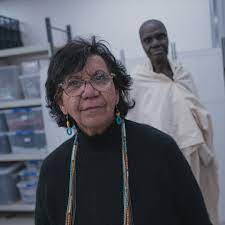
HER NAME IS A NANNY NELLIE
Australia, 2023, 78 minutes, Colour.
Directed by Daniel King.
A significant contribution to documentaries focusing on Australian First Nation’s history and issues.
Below is the official statement from the director, Daniel King.
The issue is statues being made of aboriginal men and women and children, to be exhibited in the Australian Museum. Descendants of Nellie Walker, make contact with the Museum, with experts, who are working on the statues made, adapting them for a more contemporary perspective on the subjects, more respect for them.
The point is made that with the assimilation policy, it was assumed that full blood aboriginal men and women would disappear, so that the statues, artificial and stylised, would be Museum reminders of the past.
The film is very emotional with two women in their quest, the memories, research, discussions with curators, discussions with artist and restorers, respectfully bringing to life their ancestors, the reality of their lives, the withdrawal from exhibition until a more balanced and respectful display was possible.
“Statues are made to honour Gods, and people of historical importance, to remind us of values to honour. In 1925 the Australian Museum statue made a statue of my mum’s great grandmother. But she wasn’t being honoured. She was made because of how she looked. She was made as an object to be studied. But she wasn’t just an object to be studied. Her name was Nellie Walker. She was an Aboriginal woman who lived for 67 years, under the Aborigines Protection Board, who loved and bore three children, but who had then taken away.
In 1925 the Australian Museum put 3 statues on display; naked but for possum skins, and nameless. Now my mum Irene wants them back on display, with their names, and stories. She will retrace Nanny Nellie’s life, from the Museum’s archives, to key places in her life. It will culminate when the statues are unveiled again in the Museum. This is a documentary about reclaiming our history, to change how we remember and represent, to give the nameless names.”
Daniel King
Kitchen, The/ 2023
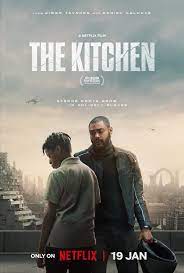
THE KITCHEN
UK, 2023, 107 minutes, Colour.
Kane Robinson, Jedaiah Bannerman, Hope Ikpokul Jr, Demmy Ladipo, Ian Wright.
Directed by Daniel Kaluuya, Kibwe Tavares.
Promotion of The Kitchen contains the description sci-fi. Perhaps. But, it might be better described as “futuristic”, indications of a dystopian future. However, in many aspects, this future has many similarities to the present.
The film has been co-written and directed by Oskar-winning actor, Daniel Khalili a (who does not appear in the film).
The Kitchen is an area of a future London, something of a segregated neighbourhood, touch of the ghetto, inhabited by large population of black British. Part of the survival is a celebration of this culture, music and dancing, gatherings, support. But, the inhabitants of The Kitchen are under threat from invading police, armour, helmets, visors, weapons and often unbridled violence. The visuals of The Kitchen are quite striking, the vast apartment blocks, small, absence of water, open to the neighbours, the streets, the shops…
We are introduced to the central character Is the (Kane Robinson) who has ambitions to move to a luxurious new apartment is on the waiting list. He works at a futuristic funeral company, arranging for the ashes of the deceased to be transferred to pots for the growing of memorial trees. He is something of a loner, but associates in The Kitchen and at work.
The other central character is a young boy, Benji, Jedediah Bannerman, whose mother has died, who does not know who his father is (immediate audience suspicion is that Is the is his father), at the funeral home, the tree for his mother.
What emerges is easy becoming a father figure to Benji, bonding, accommodating him in his apartment, sharing discussions, taking him to a skating rink, Benji and his first possible kiss there, then Izi disappearing and Benji with some kind of disillusionment. And, then, there are the attacks by the police, Izi going to his new apartment and the dilemma of whether he will ask the double accommodation there, clashes with Benji, reconciliation, especially with his mother’s tree.
There is a final attack, brutal, but the inhabitants of the The Kitchen overcoming a police squad. And the film ends – leaving the audience to wonder about the future, but hoping for the future.,
- The title? Expectations? The district of London, ghetto, inhabitants, poverty, police invasions?
- The film described as science-fiction, dystopian? Yet not so far from contemporary situations?
- The atmosphere of the kitchen, visual, crowds, accommodation, crammed, facilities, the cutting off of the water, the shops, the raiding of stores?
- The focus on Izi, age, experience, living in the kitchen, wanting to move, his name on the list for a luxury apartment? The episode of shaving, his using the water, the queue, reactions? His going to work, the contrast, the funeral parlour, arrangements, clients, the use of trees, the remains in fostering trees? Mementos? Those working, his friendship with Jase?
- Benji, the death of his mother, his devotion to her, her funeral, the discussion about the trees, his talking with Izi? Izi knowing his mother? Audience suspicions? Fatherhood? Izi and his care for Benji?
- Benji, his age, searcher his father, needing a father? Bonding with Izi, going to the kitchen, to Izi’s apartment? And his character, qualities, potential? Izi and his care?
- The outings, the skating, Benji seeing the girl, talking, the attempt to the kiss? Izi talking with Jase, disappearance? With Jase, learning he had a daughter? The presence of Staples, his role in the kitchen, revolutionary, friendship with Benji, recruiting him?
- Life in the kitchen, the possibility for meals, the restaurant? But the police invasions, armed, violence? Attacking the citizens, the chaos? Taking some of the citizens away? Later the file of citizens moving out of the kitchen? The range of people, mainly black, the black culture, music, dancing, joy, meals? And the banging of utensils to warn that the police were coming?
- Popular black culture in the UK, in London, gatherings, celebrations, meals, the skating, music and dancing, language and idiom?
- Lord Kitchener, the radio, wake-up, warnings, encouragement, his playing music? Attacked and killed by the police? Izi and his funeral?
- Benji, upset with Izi, is his return, the tension, the resolution, the meal? His wanting his mother’s tree?
- Izi, the notification of the new apartment, computerised contact, the voice, the decision about single occupation or double? His going to the apartment, luxurious?
- Is returning, the police invasion, escaping to the apartment, the discussions, Izi’s admission that he was Benji’s father? Leaving Benji alone? Going back to the funeral company? Bringing home the tree, the going to the roof, replanting it?
- The bonding, Benji finding his father and father figure, the effect on Izi? The film ending – their future?
Time/ Series 2
TIME
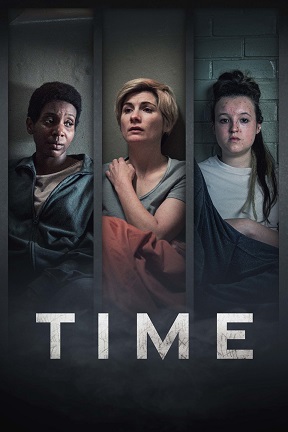
UK, 2023, 3X 60 minutes, Colour.
Jodie Whitaker, Tamara Lawrance, Bella Ramsey, Siobhan Finneran.
Directed by Andrea Harkin.
The initial series of Time, written by Jimmy McGovern (cracker, priest) focused on a men’s prison, Sean bean is a prisoner, the impact of life in prison, his relationship with his wife and family, with Stephen as a guard, compromised with drug dealing in the prison.
In the second series, the focus is on a women’s prison, again written by Jimmy McGovern but with a female collaborator. The tone is very different from the first series. The atmosphere in women’s prison is certainly very different from the atmosphere in a male prison.
The film focuses on three central characters. Jodie Whitaker plays a mother who is convicted of fraud, trying to support her children, and, on release, again committing fraud and sentenced to prison. She is middle-aged, working class, tough yet vulnerable, an alcoholic mother, hearing her children will be taken into care, her oldest child hostile to her.
Tamara Lawrance plays a mother convicted of murdering her child, attacked by the other prisoners, and, at the end of the film, explanations given about her life with her husband, the pressures, her decision. In the prison, while she is attacked, she also is supportive of a young pregnant prisoner and helps in the delivery of her birth.
The third character is played by Bella Ramsey (The Last of Us), young, drug addict, taking drugs in prison, discovering she is pregnant, and this changing her whole perspective on her life, her relationship with her boyfriend, pusher, and her having to make decisions about giving him up to the law and the possibilities of getting her baby back.
Also in the story is the prison chaplain, a nun played by Siobhan Finneran, who has her own story (a relationship with a priest) but who is a good listener to each of the prisoners, runs discussion groups, sometimes has a powerful influence on the prisoners.
Quite a moving and insightful experience, perspectives on women in prison.
- The impact of the first series? Men’s prison? Transition to women’s prison?
- The title, doing time? Indication of days, sentences?
- The screenplay by Jimmy McGovern, his career, television series, films? The insights of the first series? Cowriting here with a female writer? Sensibilities?
- Three parts, three central characters, crises and resolutions, interactions?
- The visuals of prison, add in the countryside, the range of buildings, the exteriors, the roads, the gardens? The interiors, brooms, the common room, the cells? Visitors room? Court sequences? The musical score?
- The credibility of the stories? Women’s stories, their psychology, women’s crimes? Murder, drugs, fraud? Issues of violence? The range of characters, race, culture? The interactions, violent, verbal, angers, taking hostages, humiliations? The overall credibility?
- The authorities, and then guardian to remote, the guards? The women, treating the prisoners, the rules, likes and dislikes, helps and hindrances?
- The character of the chaplain, Catholic background, none, counselling, the capacity for listening, setting up the groups, the effect of the groups, the interactions with Orla, with Kelsey, with Gabi, and Gabi’s story, reluctant? The invitation is the group? Her own story to Gabi, the priest, the relationship? Her effect as a chaplain?
- Orla, single mother, the three children, her own alcoholic mother, trying to manage, the need for money, the commitment of the fraud, the arrest, her reactions, the sentence? The cell, with the others? The visit of her mother and reprimanding her mother? Her mother’s promises to help the children? The three children, Kyle and his resentment? Phone calls to her mother, the contacts, her failing, the issue of custody of the children? Released, the repeat fraud, her return? The relationship with Kelsey, helping her? The relationship with Gabi, initial antagonism, the help? The siege situation, the knife at the throat of the prisoner, her frustration to make representations to the authorities? The help of the chaplain? The new sentence? Kyle, his birthday, the phone calls, his not coming, ashamed? Finally leaving, the tent accommodation, the meeting with Kyle, the promises?
- Gabi, accused of the murder of her baby, race issues, the way she was treated in prison, the various attacks, slicing her, the humiliation of her clothes in the shower? Her relating with others, reserve? Her sponsoring of Kelsey, helping with the birth of the baby, the baby called Daniel after her own baby’s name? A caring person? The relationship with the chaplain, discussions, going to the meetings, the women’s reactions, condemnation? Telling her story, the flashbacks, the relationship with a husband, the birth, depression, the crying baby? Killing the baby? The final meeting, her story, the group hearing it, the final promises? And her being the facilitator for the chaplain to tell her story?
- Kelsey, her age, on drugs, her attitude, going to prison, taking the drugs, their being smuggled in? The relationship with Adam, the drugs? Discovering she was pregnant, the decision to change, take no drugs, the possibilities of being a mother, the months passing, the treatment by the others, the difficulties of the birth, Gabi sent helping? Calling the baby Daniel? Adam and his visit, smothering smuggling the drugs, her being arrested, the cell, the possibilities for the future, the anguish and letting the baby go? The various threats? The court, her giving up Adam, his threats, the return of the baby, the applause as she left prison?
- Gabi, the visit from her husband, his next marriage, the visuals of the past, his treatment of Gabi, of the child?
- The drunk mother, receiving the card, her son, the other woman and her motivation for sending it? Her son hating her? The division of the chaplain, the meeting for restorative justice and reconciliation?
- Images of Justice, punishment, care, rehabilitation?
The Laity of the Chevalier Family, Days 6,7,8.
The Laity of the Chevalier Family, Days 6,7,8.

Day 6: The day started with beautiful contemplative prayer sessions from the European delegates.
Next, Fr Hans Kwakman MSC, the current Spiritual Companion of the Laity of the Chevalier Family, provided a deep theological analysis of Laudato Si, Laudate Deum, and Fratelli Tutti in the context of Spirituality of the Heart.
A presentation by Aidan Johnson from Australia followed and gave us practical ways to respond to Laudato Si as individuals, communities, and National Councils - advocate, educate, and celebrate. Everyone left feeling motivated to act in caring for our common home.
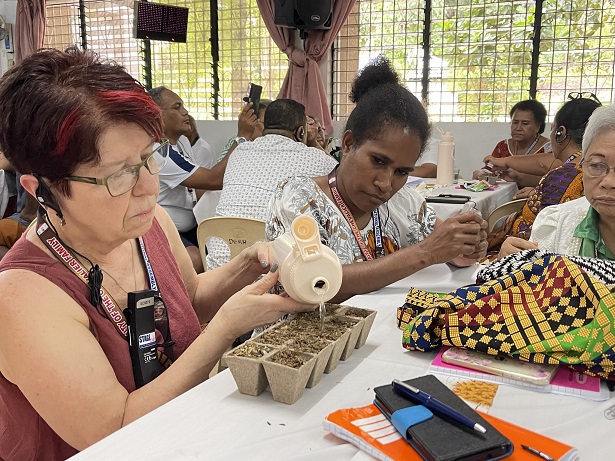
We had a seed planting ceremony, symbolic of the idea that ‘from little things, big things grow’. Our actions, no matter how small, have an impact and our collective efforts have a big impact. Each country then made a clear and concrete commitment as to what they would do when they returned home.
The Europeans provided an inspiring Eucharist, where the lay stood alongside the professed in celebrating the mass.
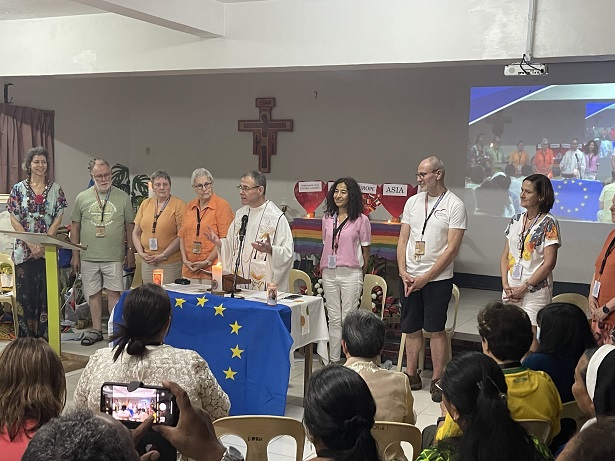
The evening ended with a great evening showcasing the many cultures and talents of the Chevalier Family. The joy, laughter, and spirit of family was uplifting.
Day 7: The delegates enjoyed an immersive contemplative prayer, led by the Oceania delegates, outside in the retreat centre gardens.
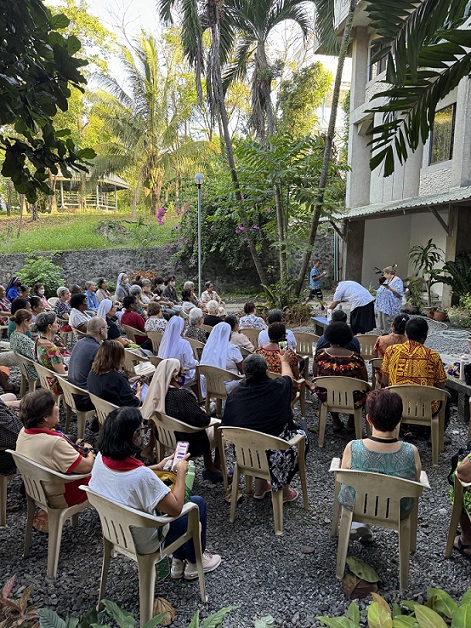
A keynote address from Alison McKenzie focussed on the organisational aspects of the Laity of the Chevalier Family, forming the lay within their countries, and the role of Spiritual Companions in accompanying the laity. Each country discussed their local context and came up with practical next steps for organising their laity.
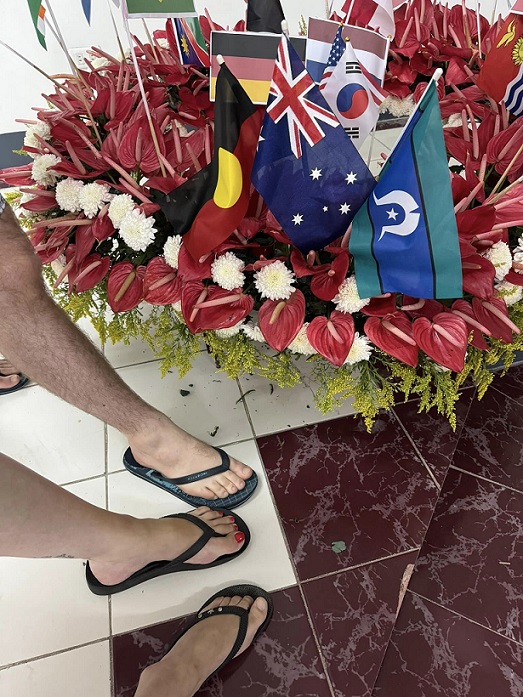
Next, we had a collaborative Eucharist led by the Oceania delegates, with the different country languages, symbols, music, and dances incorporated into the liturgy. The lay were empowered to full participation in the celebrations from a circular seating arrangement to a homily by Australian lay delegate Clare Johnson that challenged us to embrace growth and transformation.
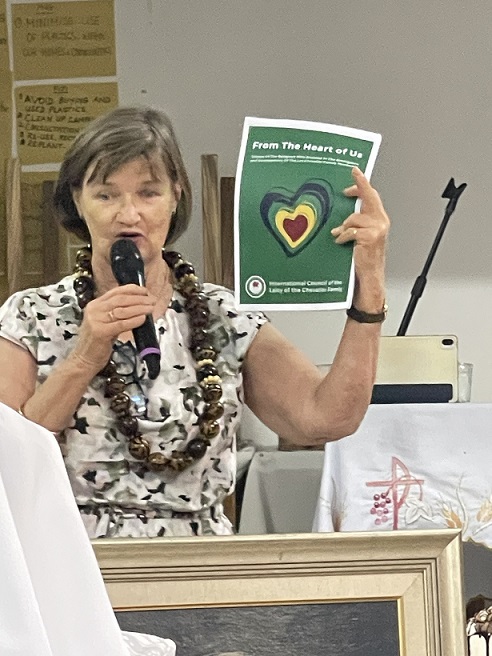
The draft of the From The Heart of Us book was launched honouring the ‘religious who assisted in the emergence and development of the lay Chevalier Family movement’.
The evening finished with a celebration of Jules Chevalier’s 200th birthday anniversary and a special Zoom guest appearance by Fr Hans Kwakman and a French delegate with connections to Issoudun. A giant cake was cut!
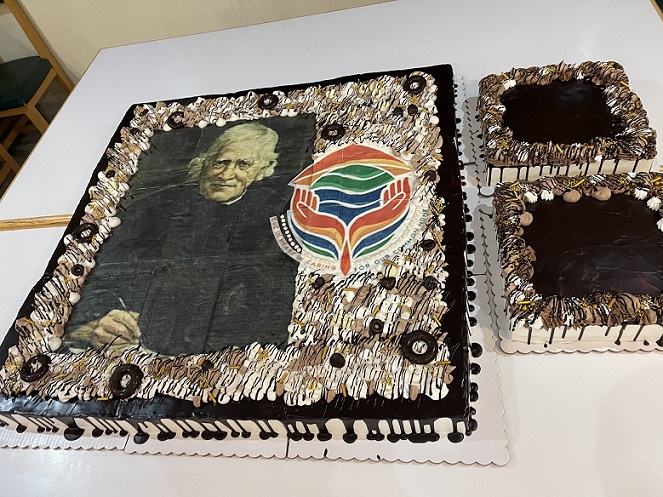
Day 8: The day started with a contemplative rosary from the Americas and then a thought-provoking opening prayer from Namibia.
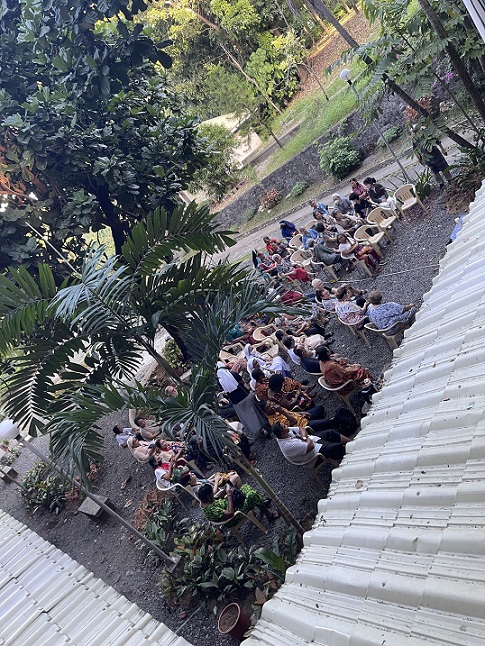
The keynote speaker was Rita Clueren from Belgium on ‘The journey of the heart always leads to a journey to the world’. A very inspiring lecture that directed us toward those who are not seen and not heard, such as the homeless. It was a call to open our eyes and live the mission of a ministry of presence.
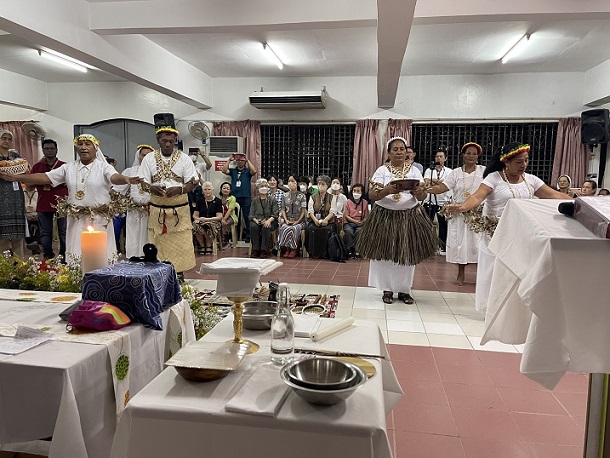
We discussed the revised ‘General Guiding Principles and Organisational Directions of the Laity of the Chevalier Family’. Lively discussions were had on the Guiding Principles section and clarifications were made, before the voting commenced. The alterations agreed to will be presented in the minutes. The Organisation section review was a presentation of suggestions and remarks to the International Council for consideration and possible later incorporation into the document. Then onto the Finance section! Alison McKenzie provided an overview of the last 7 years - what money came in and where it went. Then there was a discussion about each country making a financial commitment to support the International Council. The final vote agreed that each country would contribute a minimum of US$100 annually in June, with countries able to give more if they are able. At last we have an official arrangement! Another step forward!
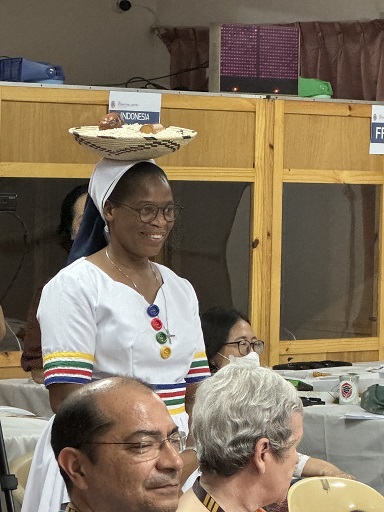
The Indonesian delegation celebrated the Eucharist with beautiful songs and singing.
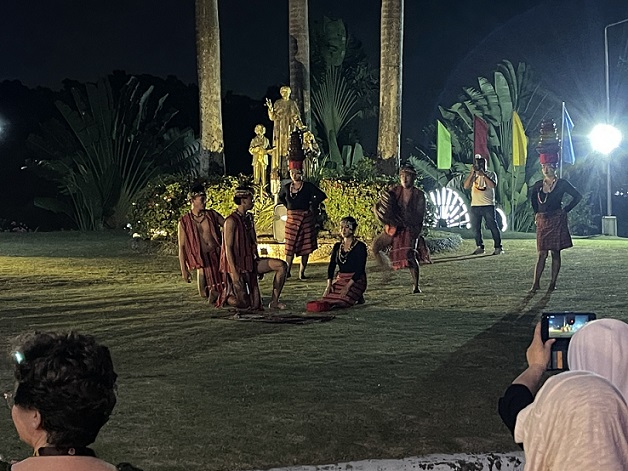
The night closed with an outdoor party (fiesta time!). Dinner was excellently prepared and tasty. A thank you to the catering staff who have been feeding us! There was traditional Filipino music and dancing, and the inevitable playing of ‘I love Cebu!’ to get the crowd on their feet and dancing into the night. It was a glorious way to almost end the conference. It's hard to believe tomorrow is the last day!
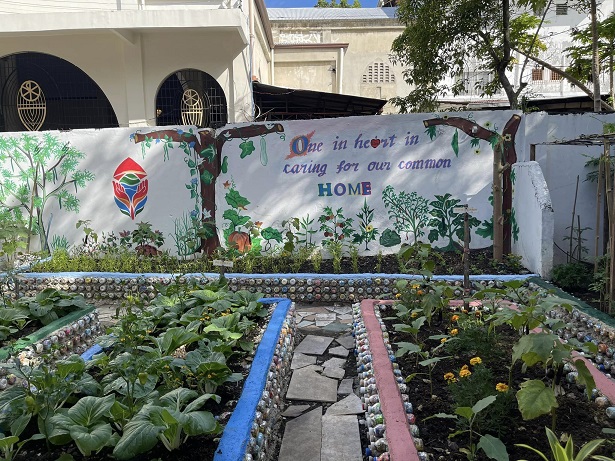
It has been such a privilege and incredible experience participating in the General Assembly for the International Laity of the Chevalier Family with 140 members from 25 different countries. The gathering was in Cebu, Philippines and the theme of our Assembly was ‘One in Heart in Caring for our Commin Home’. We will return home with new friends and a furm resolve to try and do our best in our own small way to care for our damaged planet and each other.
Update on the student's house building in Thu Duc, Vietnam
Update on the student's house building in Thu Duc, Vietnam
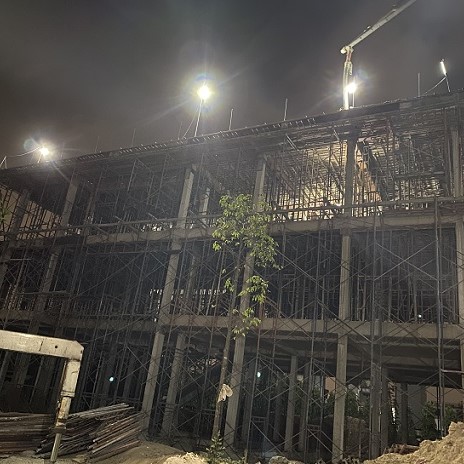
With thanks to Trieu at present in Vietnam for these vivid night photos – of building, equipment and onlookers

Last night, they concreted the roof of the building.
Here are some photos of the work that they did.
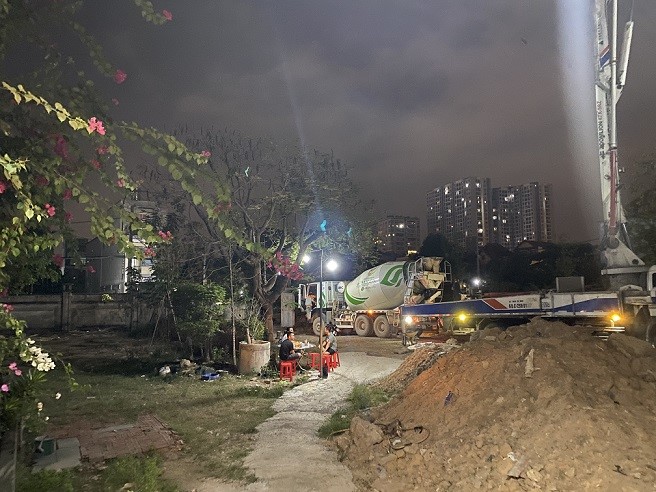
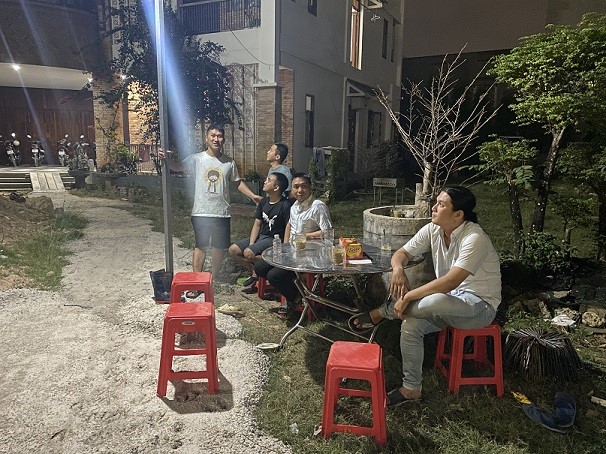
Laity of the Chevalier Family, Days 4 and 5
Laity of the Chevalier Family, Days 4 and 5

Re-election of Alison McKenzie, Secretary General
Day 4: The day started with the morning prayer, prepared by the Korean delegation.
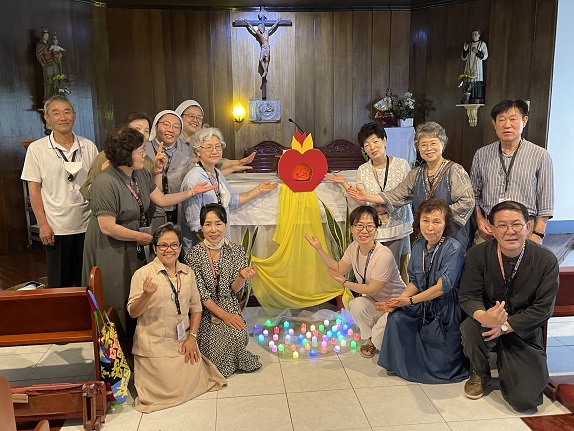
The keynote speaker of the day was Boni Dano. His lecture entailed why choose the Spirituality of the Heart? It is life giving. It inspires us in our way of life. It opens our hearts to healing the ills of the world. In humility we can truly live.

Live HEARTILY - Humility, Empathy, Active Participation, Reconciliation, Trust in God, Interconnectedness, Love, and Yearnings. A delegate said in A problem can be a gift if we see it as an opportunity for growth. Something we can build on and be transformed by.
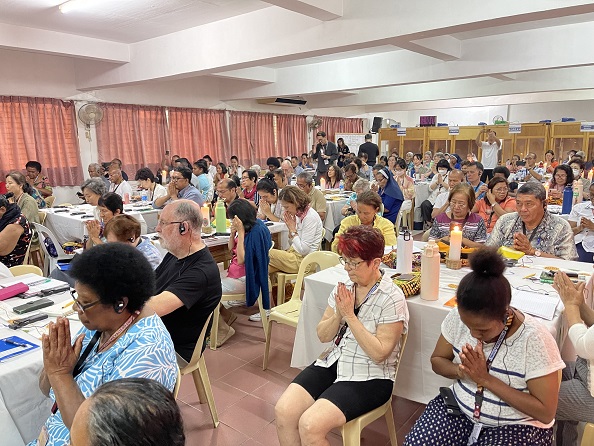
After the coffee break there was sharing from the regions: Europe, Central and South America and the Caribbean, and Asia-Pacific. So interesting, but also moving to see how these different lay groups experience and live Spirituality of the Heart.
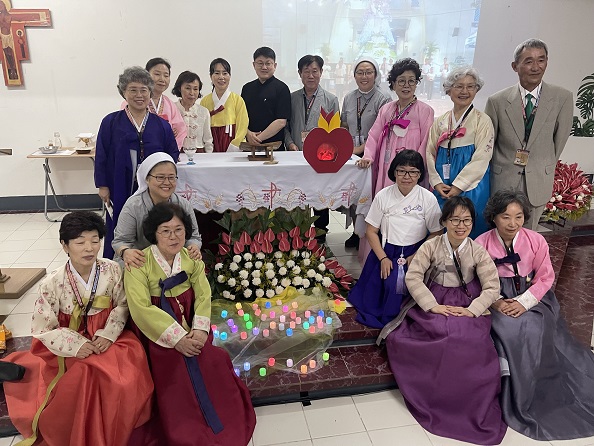
After lunch we continued with spiritual sharing - reflect, share, listen, and discern. A very inspirational exercise!
The Korean delegates prepared a beautiful mass with music, including traditional Korean drums.
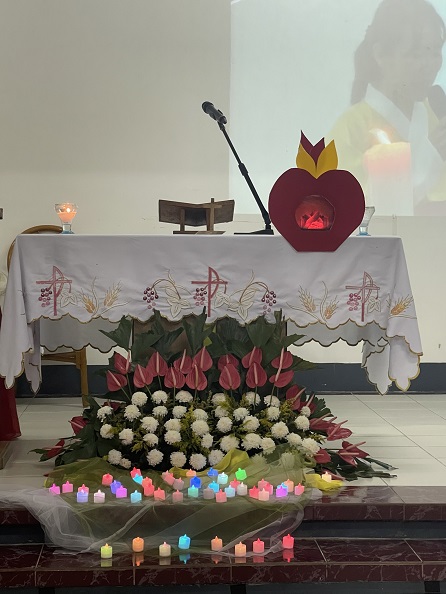
After dinner, the voting procedure started. With the majority of votes, Alison McKenzie was re-elected for the coming six years. Her acceptance speech was very moving and inspiring. A new era awaits!
Day 5: An early breakfast today as we went on pilgrimage to the basilica of Senor Santo Nino.

The basilica is based near where Ferdinand Magellan planted a cross in 1521. The image of Santa Nino was found by an expedition in a house near the present site. We visited the museum, which has gifts and donations from people who wanted to thank Santa Nino for his intercessions. The collection varies from clothing to rosaries and silverware and so much more - Incredible! The basilica reminded me of colonial times.
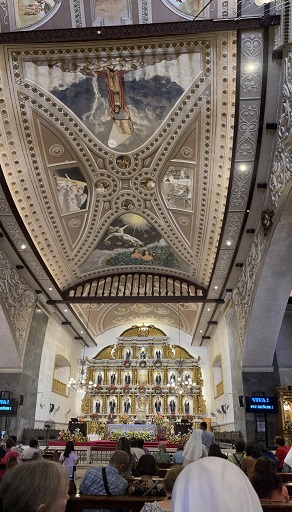
A very large but beautiful building where you can feast your eyes on the stained glass windows (which I love), the main altar, and the vastness of the inside of the building. Here we celebrated mass, with Father Absalon, the MSC Superior-General presiding. It was heartwarming to hear him speaking about the laity - he introduced us to the other pilgrims who also attended the mass and explained briefly our spirituality.
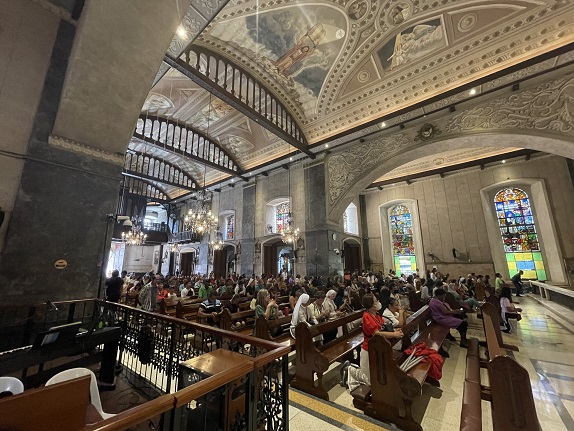
Then we went to the mall where we had an excellent buffet lunch with food choices from all over the world.

Then… shopping! For many a must, for others a burden. The big and well-equipped shops were nice to see, yet at the same time we reflected on the poverty just outside the shopping centre.
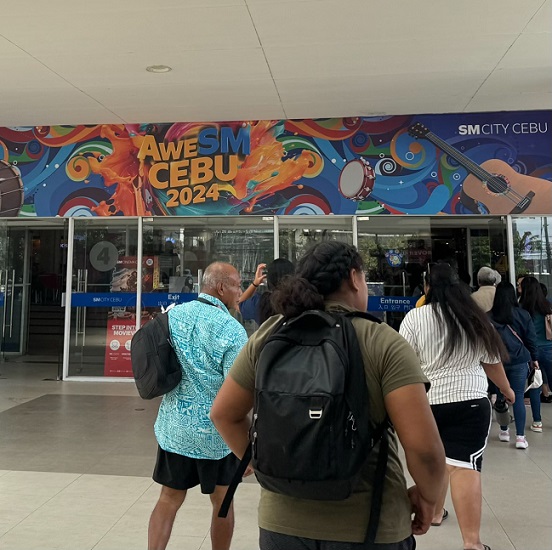
We headed back to the retreat house for dinner and a much needed free evening.
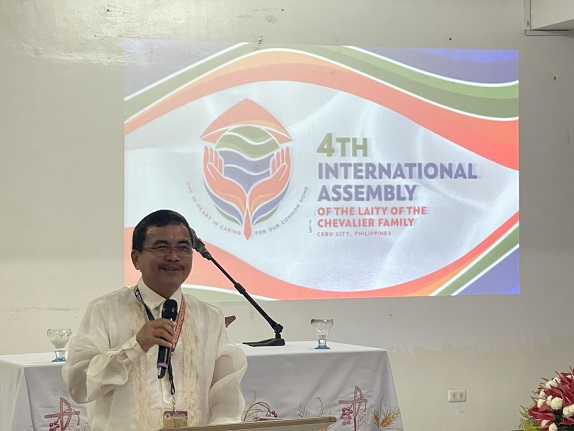
Re-election of Alison McKenzie, Secretary General
ALISON
Day 4: The day started with the morning prayer, prepared by the Korean delegation.
KOREAN PRAYER
The keynote speaker of the day was Boni Dano. His lecture entailed why choose the Spirituality of the Heart? It is life giving. It inspires us in our way of life. It opens our hearts to healing the ills of the world. In humility we can truly live.
MARIFE
Live HEARTILY - Humility, Empathy, Active Participation, Reconciliation, Trust in God, Interconnectedness, Love, and Yearnings. A delegate said in A problem can be a gift if we see it as an opportunity for growth. Something we can build on and be transformed by.
PRAYER
After the coffee break there was sharing from the regions: Europe, Central and South America and the Caribbean, and Asia-Pacific. So interesting, but also moving to see how these different lay groups experience and live Spirituality of the Heart.
ALTAR GROUP
After lunch we continued with spiritual sharing - reflect, share, listen, and discern. A very inspirational exercise!
The Korean delegates prepared a beautiful mass with music, including traditional Korean drums.
ALTAR
After dinner, the voting procedure started. With the majority of votes, Alison McKenzie was re-elected for the coming six years. Her acceptance speech was very moving and inspiring. A new era awaits!
Day 5: An early breakfast today as we went on pilgrimage to the basilica of Senor Santo Nino.
SANTO NINO
The basilica is based near where Ferdinand Magellan planted a cross in 1521. The image of Santa Nino was found by an expedition in a house near the present site. We visited the museum, which has gifts and donations from people who wanted to thank Santa Nino for his intercessions. The collection varies from clothing to rosaries and silverware and so much more - Incredible! The basilica reminded me of colonial times.
APSE
A very large but beautiful building where you can feast your eyes on the stained glass windows (which I love), the main altar, and the vastness of the inside of the building. Here we celebrated mass, with Father Absalon, the MSC Superior-General presiding. It was heartwarming to hear him speaking about the laity - he introduced us to the other pilgrims who also attended the mass and explained briefly our spirituality.
PLIGRIMS
Then we went to the mall where we had an excellent buffet lunch with food choices from all over the world.
FOOD
Then… shopping! For many a must, for others a burden. The big and well-equipped shops were nice to see, yet at the same time we reflected on the poverty just outside the shopping centre.
SHOPPING
We headed back to the retreat house for dinner and a much needed free evening.
POSTER
Australia Day, What do we think? But, importantly, why do we think it?
Australia Day, What do we think? But, importantly, why do we think it?
By Joe Horner
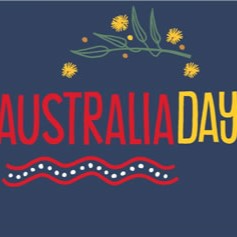
In view of the 2023 Referendum on The Voice and its defeat, worth reflection.
For some, the Australia Day public holiday on 26 January has become synonymous with clothing and accessories adorned with the Australian flag. It’s also the day thousands of people officially become Australian citizens at citizenship ceremonies across the country.
Overall, though, it is regarded as a day to acknowledge the country’s history – good and bad. The history of Australia Day has created a significant amount of controversy, with many referring to the day as ‘Invasion Day’ and advocating for the date of the public holiday to be changed. As a result of this discourse, retailers Woolworths and Big W have announced that they will not be selling Australia Day merchandise in 2024.
Below, we explain why Australia Day is so controversial so you can decide how you want to spend the day.
What is Invasion Day?

For Aboriginal Australians, who had occupied the land for over 50,000 years prior to the arrival of the British, Australia Day is a day of mourning. Many non-Indigenous Australians feel the same way, which means you may hear the terms ‘Invasion Day’, ‘Survival Day’ or ‘Day of Mourning’ used instead. As a result, the Invasion Day date is also 26 January. Many fly the Australian Aboriginal flag at half-mast and wear black clothing to protests and remembrances as a symbolic demonstration of mourning.
The date 26 January is extremely controversial because it marks the anniversary of the arrival of the First Fleet of European ships on Australian shores. It was then that the colonisation of the country began, bringing massacres, oppression of Indigenous communities, theft of land and, more recently, the Stolen Generations of the early to mid-20th century. These generations of Aboriginal children were forcibly removed from their families as a result of government policies.
As such, there have been calls for Australia Day to be moved to a date that unites all of its people instead of continuing the divide.
The “change the date” debate

The history of Australia Day is relatively short. It wasn’t until 1935 that all states and territories in Australia began using the name ‘Australia Day’ to mark 26 January, and it only became a nationwide public holiday in 1994. However, despite its relative recency, it is easily Australia’s most contentious date.
There has been much mixed public sentiment around the movement to change the date of Australia Day. For many, both Indigenous Australians and non-Indigenous Australians alike, the idea of celebrating an event that marks the beginning of dispossession and mourning for Aboriginal and Torres Strait Islander people does not feel right. In fact, it is quite uncommon for a country to celebrate its national day on the anniversary of colonisation.
Over the last few years, attitudes have been shifting towards changing the date that Australia Day is celebrated. In 2017, CNN reported that only 26 per cent of Australians wanted the date changed; however, a more recent poll by The Guardian found that 57 per cent of respondents would either support changing the date or keeping the date and creating a separate day to acknowledge First Nations peoples.

A more detailed study carried out as part of the Deakin Contemporary History Survey found that there are significant differences in attitudes between older and younger generations. It found that 70 per cent of Baby Boomers (people born 1946–65) are against changing the date, while 53 per cent of Millennials (those born between 1986 and 2002) were in favour of the change.
This material is on the website, Insider Guides, https://insiderguides.com.au/why-is-australia-day-so-controversial, written by Joe Horner, a guide for informing international students, 9th January, 2024
